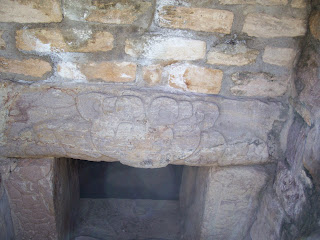 Saturday morning, Stuart and I walked down to the periferico, and caught a colectivo headed towards Tlacolula. (note: if I come back to live this life again, I want to be the conductor on a Tlacolula bus, because that word is so much fun to say!) I asked the driver to let us off at the road leading to Dainzu. Stuart came here a couple of weeks ago, when I was in the embroidery class, and said I must make this trip, too. Dainzu is a Zapotec ruin that is visible from the main highway through the valley. One of my favorite places in the valley is the ruins of Yagul, which are close by. But, today, we're visiting Dainzu. There is a restoration effort underway, and the state has the familiar signs giving a little history of the place, and a little about the site. The signs are written in spanish, Mayan or Zapotec, and english. I always read the spanish part, to test my comprehension. It's a short walk up a badly paved road to the site. It's early, it's Saturday, and there is no one here. Soon, though, the caretaker finds us, and with a smile asks for the 31 peso entry fee, which we are happy to pay. He points out a couple of things we might want to see, and wanders back to his shade tree and daily paper.
Saturday morning, Stuart and I walked down to the periferico, and caught a colectivo headed towards Tlacolula. (note: if I come back to live this life again, I want to be the conductor on a Tlacolula bus, because that word is so much fun to say!) I asked the driver to let us off at the road leading to Dainzu. Stuart came here a couple of weeks ago, when I was in the embroidery class, and said I must make this trip, too. Dainzu is a Zapotec ruin that is visible from the main highway through the valley. One of my favorite places in the valley is the ruins of Yagul, which are close by. But, today, we're visiting Dainzu. There is a restoration effort underway, and the state has the familiar signs giving a little history of the place, and a little about the site. The signs are written in spanish, Mayan or Zapotec, and english. I always read the spanish part, to test my comprehension. It's a short walk up a badly paved road to the site. It's early, it's Saturday, and there is no one here. Soon, though, the caretaker finds us, and with a smile asks for the 31 peso entry fee, which we are happy to pay. He points out a couple of things we might want to see, and wanders back to his shade tree and daily paper.There are probably more ruins, they seem to be scattered along the valley like toys. In the photo below taken from the top of the ceremonial platform, I can see one side of the ball court, and barely the village of San Jeronimo Tlacochahuya in the distance.
In tomb 7 - I've noticed that all ruins seem to have an Important Tomb 7 - there is a carving of a jaguar above the door. The animals arms hang down, creating the sides of the door. I took this picture by holding the camera through the bars that prevented us from getting any closer...
The caretaker pointed out the covered portion of the site work that protects about 30 stones with bas-relief carvings of ball players. I wished I had some newsprint and some chalk! What rubbings I could capture here! This is one of the larger sculptures, more complete than some of the others, too. The stones were literally part of the mountain, with a rock wall built around them.
It's a little cooler today than last week, and we leave the ruin site by walking west through the site. We find an animal path through some low brush, and with the bell tower of the San Jeronimo in our sight, we walk through some empty milpas, corn fields, then some fields that are being irrigated and growing corn, beans and garlic. The path eventually intersects with a dirt road. We see a few people working in the fields, and take a break under a big tree to have some bagel/cream cheese/smoked salmon left from last night's card games with our neighbors. When we begin walking again, a man meets us from his alfalfa field, and we talk a little. Jose tells us not to miss seeing the beautiful church in his home town, and we assure him that it's our intent to see it. His english is very good, but speaks spanish with me when I tell him I'm studying, and corrects me. We walk on, leaving him to supervise a small group of men who have just ridden to the fields on their bicycles.







No comments:
Post a Comment